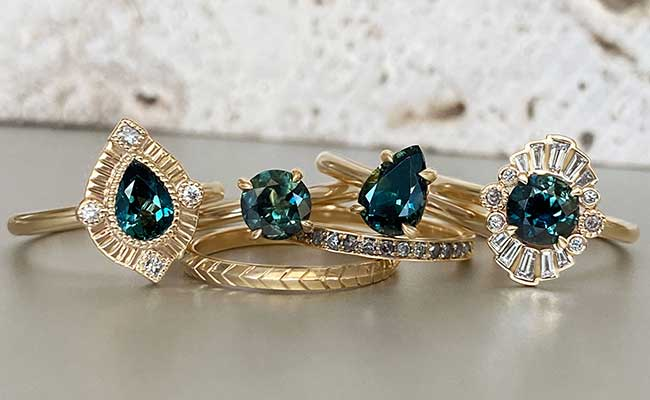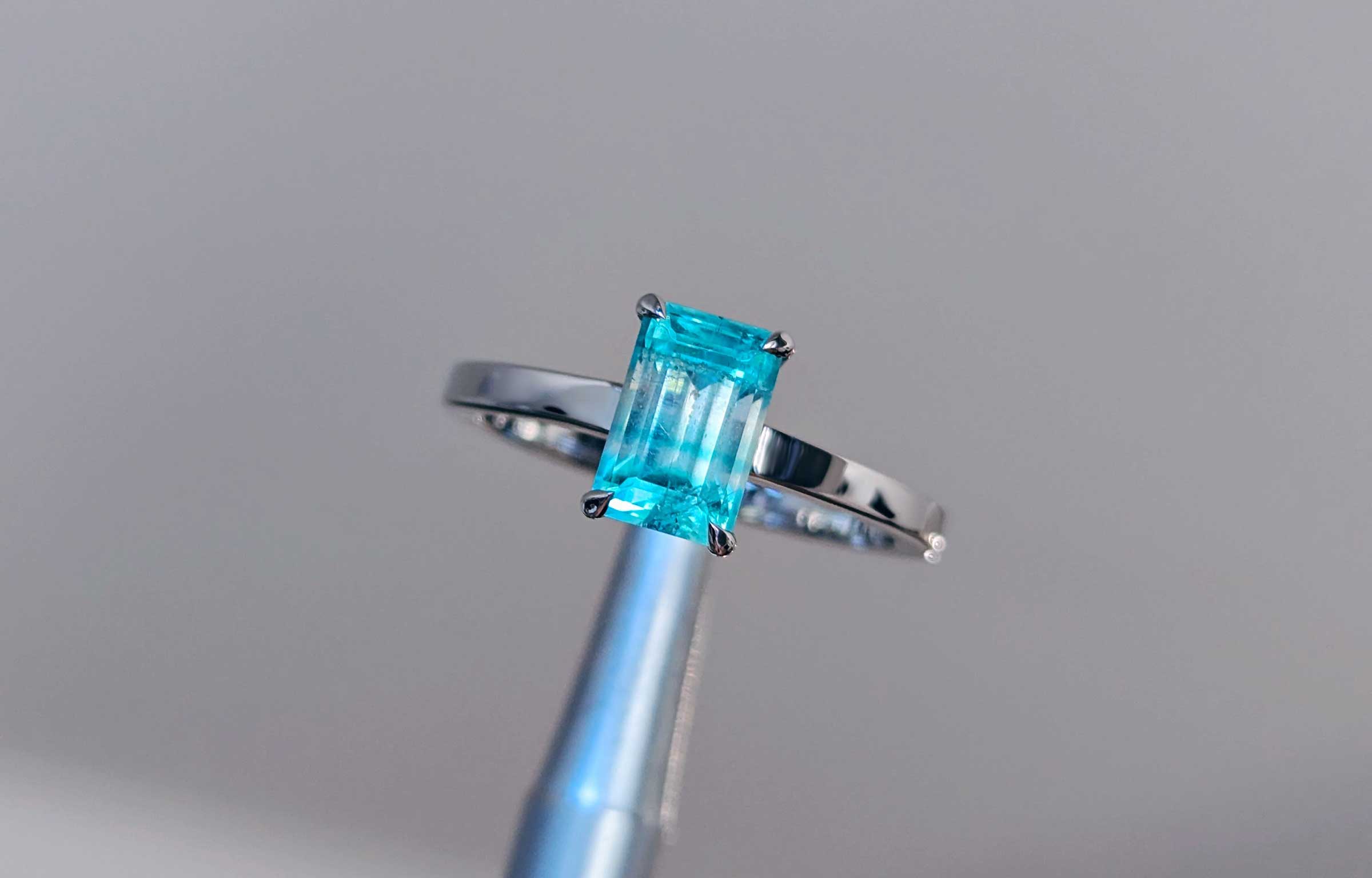
Not your grandma's diamonds: April birthstones that break the rules
April babies, you've hit the birthstone jackpot. Your birthstone is diamond. Brilliant, bold and hard enough to survive almost anything life throws your way.
You'll see it splashed across every birthstone chart, jewellery gift guide and department store window. But if you're here, we're guessing you're not the department store window type.
You're not interested in a cookie cutter gem. You're after something with substance and soul. Something that says "no" to the status quo and "yes" to unapologetic self expression.
Let's talk diamonds - the unconventional kind.

For those of you who like reading, we end this article with some frequently asked questions about April's diamond birthstone.
Diamonds, but not as you know them
White diamonds are a classic, sure. But let's not pretend they're the only gem in the April lineup. If you're after a birthstone with a little personality, here are some options that might feel a little more you.
Grey diamonds
Moody. Understated. A little mysterious. Grey diamonds are for the rule breakers who prefer quiet confidence over excessive bling. The ones with higher clarity can fetch a premium over classic whites, but what really sets them apart is their effortlessly cool, silvery hues. Think of them as diamonds in greyscale - subtle, muted and anything but boring.

Salt and pepper diamonds
They're stormy, speckled and full of character. Salt and pepper diamonds wear their inclusions with pride, showing off the flecks, streaks and patterns that most traditional diamonds would try to hide. They're often more affordable than white diamonds and are a favourite for those who love character over conformity.

Black diamonds
Black diamonds are the unapologetic drama queens of the diamond world. Unlike white diamonds, they're opaque and don't sparkle. Instead, they reflect light off their surface facets, creating a bold, inky finish that's impossible to ignore. Most black diamonds on the market are treated, making them a brilliant choice if you're after maximum impact without the hefty price tag.

Champagne, chocolate and cognac diamonds
Deliciously warm and anything but ordinary, These diamonds come in pale to rich hues that range from light, sunlit tones to deep, sultry browns. Once considered undesirable in the traditional diamond world, they're now prized for their individuality and earthy beauty. They're especially striking in yellow or rose gold and suit those who lean towards less flash, more flavour.

Yellow diamonds
Yellow diamonds are like bottled sunshine - joyful, warm and full of personality. Their colour comes from traces of nitrogen during formation and they range from soft lemon to rich canary tones.
Pricing-wise, yellow diamonds sit in a very appealing middle ground. They're often more affordable than pinks and other rare coloured diamonds, but can be more of an investment than white diamonds, especially in the more vivid yellows.
If you're looking for something with bolder colour (without leaping into ultra high end pricing), yellow might just be your shade.

Rare coloured diamonds
We're talking the showstoppers. Blues, pinks, purples and reds - these are some of the rarest and most coveted diamonds in the world. Their colours form under extraordinary geological conditions, making them incredibly scarce and sought after.
Natural coloured diamonds in these hues can command premium prices (we're talking five, six, seven and eight-figures and up), and for good reason. They're breathtaking, meaningful and one-of-a-kind. Whether you're collecting, custom designing or simply appreciating from afar, they represent the pinnacle of individuality and rarity in the diamond world.

Lab created diamonds (yes, in colour too)
Lab grown diamonds have come a long way in recent years. Chemically and visually identical to mined diamonds, they offer the same brilliance and durability at a more accessible price point. They're now available in a growing range of colours like blush pinks, vivid yellows, icy blues and more. If you've ever dreamed of owning a rare coloured diamond without the sky-high price tag, this is where things get interesting.
For those of you looking at lab diamonds as a more ethical, environmentally friendly choice, opt for Sustainability Rated or carbon neutral lab diamonds.

Curious about how lab created diamonds compare to mined ones? Here's everything you need to know.
What does your April birthstone jewellery look like?
Choosing birthstone jewellery isn't about status. It's about identity. These are three of the best ways to find your April birthstone keepsake right now:
- Shop our ready-to-order collection
- Explore our one-of-a-kind gemstones
- Start your custom design journey
Diamond FAQs: Your April birthstone questions answered
For those of you who can't get enough of April's birthstone, here are some frequently asked questions to turn you into a diamond know-it-all. Got a burning question that's not covered here? Get in touch and we'll add it to the list.
- What is the birthstone for April?
- What are alternative gemstones for April?
- What colour is April's birthstone?
- How do I incorporate my birthstone into jewellery?
- What zodiac signs are associated with April birthstones?
- What does April's birthstone symbolise?
- How did diamonds become the go-to for engagement rings?
- Are diamonds good for everyday wear?
- Are diamonds rare?
- How do the costs compare between mined and lab created diamonds?
- What's the most ethical choice when it comes to diamonds?
What is the birthstone for April?
Revered for centuries for its durability, brilliance and symbolism, diamond is the official birthstone for April. But even if the traditional white diamond doesn't feel right for you, there is a whole spectrum of other options to explore, from classic whites to moody greys, bold blacks, warm champagnes and rare coloured hues. Book a custom jewellery consult to find your perfect diamond.
What are alternative gemstones for April?
If a diamond doesn't quite feel like your style, there are a few modern alternatives worth exploring. Gems like sapphire, opal, white topaz and clear quartz often appear on contemporary birthstone lists as alternatives to the traditional April birthstone. If you're after something a little different, it's good to know you've got options.
What colour is April's birthstone?
While diamonds are best known for being colourless, they actually come in a surprising spectrum of hues, from soft greys, golden champagnes and vivid yellows to rare blues, pinks and reds.
How do I incorporate my birthstone into jewellery?
Think beyond the solitaire. A diamond can be set off-centre, clustered with coloured gems, hidden on the inside of a band or cut in a shape that's far from traditional. Whether you want your birthstone to shine centre stage or play a supporting role, it's about telling a story that's unapologetically yours. Want to find out how? Explore our guide to designing a unique engagement ring for inspiration.
What zodiac signs are associated with April birthstones?
April covers two zodiac signs: Aries (March 21 – April 19) and Taurus (April 20 – May 20). Aries is traditionally linked to diamonds and bloodstones, while Taurus is associated with emeralds. While diamonds are the official birthstone for April, zodiac stones offer an alternate path. If a diamond doesn't speak to you, consider letting your star sign point you in another direction.
What does April's birthstone symbolise?
Diamonds symbolise strength, clarity and enduring love. For some, that means resilience after a difficult chapter. For others, it's a celebration of unwavering commitment to a partner, a purpose or a part of themselves.
How did diamonds become the go-to for engagement rings?
We have De Beers to thank for that. In 1947, their now-iconic 'A Diamond is Forever' campaign linked the durability of diamonds with the idea of everlasting commitment, cementing them as the go-to stone for engagement rings around the world.
But De Beers didn't stop there. They also introduced the idea that your ring should cost one (then two, then three) months' salary, turning engagement rings into status symbols and setting expectations that still linger today.
Let's be clear. This is not the notion we subscribe to.
You don't need to follow tradition, a marketing slogan or someone else's rules to create something meaningful. A ring should reflect your story, your values and your love. Whether it's a diamond, a sapphire or a wild and wonderful gem you chose on a whim, there's no rulebook here. Just good design and a damn good story.
Are diamonds good for everyday wear?
Yes, diamonds are the hardest known gemstone, which makes them an excellent choice for engagement rings and daily wear. But hard doesn't mean indestructible. Diamonds can still chip or fracture if hit at the wrong angle. So while they're incredibly durable, a little care goes a long way. Take them off when doing anything rough or hands-on, and they'll keep sparkling for generations to come.
Are diamonds rare?
In short, not as rare as the marketing would have you believe. While diamonds are often positioned as ultra-precious, most commercially available stones are relatively abundant.
That said, some are genuinely rare, like vivid coloured diamonds (think pinks, blues and reds) or stones with exceptional clarity. These are the true unicorns of the diamond world, and their value reflects that.
But rarity isn't just about geology. The real magic is finding a diamond that feels like you. And with the right guidance, that shouldn't be rare. In fact, we think it should be the norm.
How do the costs compare between mined and lab created diamonds?
Lab created diamonds are more affordable than their mined counterparts, with prices dropping significantly in recent years. This means more flexibility in your budget and the option to go bigger, bolder or more unique. If you're weighing up the difference between a lab grown and a mined diamond, we'd happy to walk you through the differences in a custom jewellery consult.
What's the most ethical choice when it comes to diamonds?
There's no one-size-fits-all answer. The truth is, ethics in lab grown and mined diamonds is a complex topic and what's right for someone else might not be right for you.
Diamond mining can have serious environmental and social impacts, including destruction of ecosystems, contamination of air and waterways, and displacement of wildlife. However, they can also support small-scale, community-focused operations that provide vital jobs and income in regions that need them most.
Lab grown diamonds avoid many of the environmental and social issues linked to mining, but they come with their own impact, such as a high carbon footprint.
We're here to help you ask the right questions and make informed decisions. Book a custom jewellery consult and we'll help find the diamond that's right for you.





